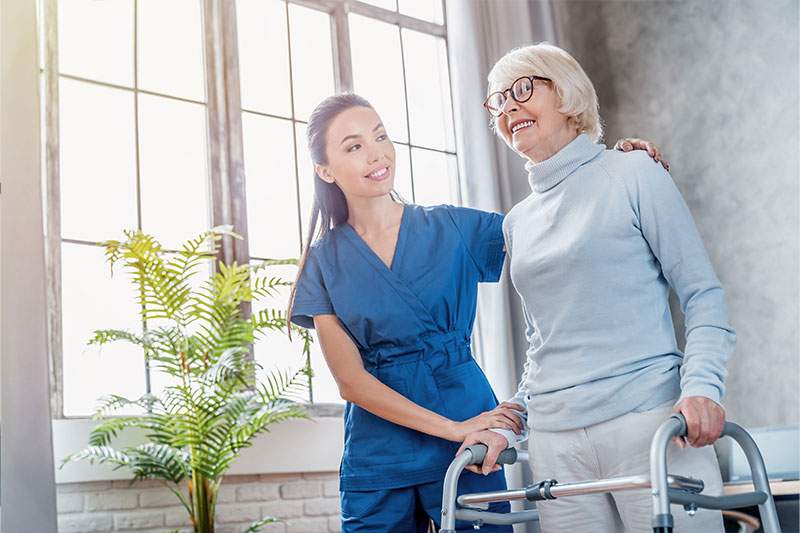As we age, we tend to lose mobility in a variety of ways. Our core strength, balance and coordination can diminish, making certain types of movement uncomfortable or even impossible. Fortunately, mobility issues are very manageable. By keeping an eye on their progression and taking appropriate steps to address the difficulties they cause, you can help your loved one keep moving with confidence as they age.
Signs That Mobility Issues Are Worsening
Most seniors have some level of mobility loss. It tends to progress unpredictably over time, making it important to learn the more subtle signs they may be struggling.
Here are some common signals to look for:
- New, unexpected or unusually intense pain. Joint issues and arthritis tend to cause pain in consistent ways, specific locations or in response to moving in a distinct way. If the pain starts manifesting in different situations, or if it gets significantly worse, your loved one’s condition may be progressing.
- Changes in gait or movement style. Mobility loss naturally impacts how seniors move, but not always in ways they’re aware of.
- Doing daily tasks slowly. Mobility issues can make many daily tasks like getting up, dressing, bathing and using the bathroom slower and more difficult.
- Anxiety, frustration or shame. Mobility loss can produce a variety of emotional reactions, but these three are some of the most common responses when it gets worse.
How to Help Seniors Manage Mobility Issues
With the right assistance, it’s possible for seniors to stay active, reduce risk of injury and even regain some lost mobility. Here’s how you can help:
- Help Them Avoid Falls and Injuries Mobility issues aren’t just about discomfort and trouble getting around. They also frequently include loss of strength, balance and coordination, all of which can make seniors prone to falls and other injuries. In fact, falls are the most common cause of injuries among older adults.
However, because falls are such a common problem for seniors, there are a huge number of resources and elderly fall prevention tips to help. One of the most important things is to be aware of risk factors for falls in the elderly. By keeping these risks in mind, you can make adjustments to help your loved one go confidently about their day.
- Help Them Improve Their Balance By getting regular exercise, seniors can slow or prevent mobility issues—or even reclaim some of their lost strength and coordination. While most forms of movement can help, certain programs like balancing exercises for seniors are specially designed for the task. Not only do these gentle workouts help them build strength and stability, but many of them are also taught to a group. Turning your loved one’s workout into a regular social occasion is a great way for them to connect with friends and find the motivation to keep showing up.
- Get Them Mobility Aids Many seniors avoid going out or getting moving out of a very understandable fear of falling. Unfortunately, this prevents them from getting the exercise they need to maintain their mobility, on top of making it harder for them to enjoy life.
If your loved one is worried about falling, try looking into mobility aids for seniors. With the added stability these tools offer, older people can stay active, regain their independence and explore the world around them.
- Help Them Clean Up Most senior falls happen in the home. There are many reasons for this, but one of them is that for seniors, clutter is a much greater concern than it used to be. Minor annoyances like shoes and pet toys collecting in walkways can become home hazards for elderly people, so it’s important to clean them up promptly.
Unfortunately, cleaning up is also a fall risk because it tends to involve a lot of bending and reaching motions. That’s why it’s best to handle as much of your loved one’s housekeeping as possible—or schedule them regular visits from a cleaning service.
- Use Some Elbow Grease Another reason senior falls are common at home is that their homes may no longer serve their needs. The good news is that many of these issues can be solved with a little home maintenance and improvement.
Start by fixing lightbulbs, adding night lights close to the floor in hallways, tightening up (or adding) railings and adding reflective tape to the edges of stairs. Next, make sure to add grab bars next to toilets and tubs. Don’t be afraid to hire a handyman for tougher improvements like tightening up loose carpets and installing elevators.
How Caregivers Can Help Seniors With Mobility Issues
One of the best ways to help seniors stay independent and move around confidently is to get them help from a professional caregiver. Caregivers offer home care for disabled adults, helping them with many daily tasks like bathing, dressing and transportation. They may also offer help with cooking and housekeeping, and help from FirstLight Home Care can even make vacations easier through senior travel companion services.
Want to learn more about how our caregivers can help your loved one stay mobile? Contact us today!
